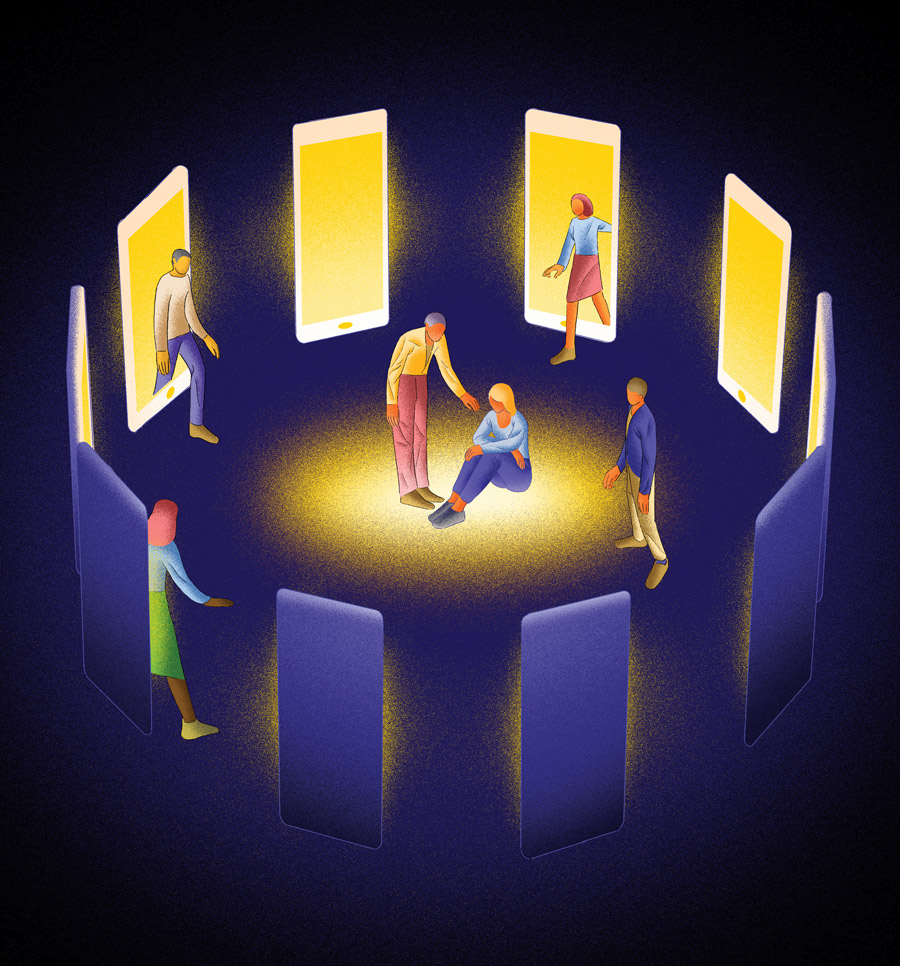
Illustration by Wenkai Mao
Nothing turns a conversation from casual to awkward faster than when a stranger asks what I do for work. “I run an app for grief,” I say with a smile. There’s a moment of silence—the kind where a person fumbles for an appropriate response. Death, after all, is a conversation killer. I throw out an explanation to fill the silence: “The app connects people mourning the loss of a loved one so that they don’t feel alone.” Some respond with a knowing nod. Others promptly pivot to the weather.
Western culture idolizes feeling good, making us chronically incapable of facing human fragility. People shun discussions of death. They fear talking about grief. If you haven’t yet squirmed in grief’s grip, I’m sorry to say, it’s ahead. And yet grief is as natural as joy—and a normal response to the many ways we lose love. Running a grief app, and navigating my own losses, have offered some insight into how people process pain. It’s messy and it takes time, but what’s also true is that we are designed to come out the other side. And it all begins with human connection.
The Goodgrief app, which launched in 2018, is simple: New members create profiles based on the loss they suffered, and then can initiate or accept conversations with others via in-app texting. Their opening sentences often sound almost identical: “I’m here for support,” is typical. These are moms whose babies died during birth. Men whose wives didn’t survive cancer. Sisters who found a sibling post-suicide. Spouses in the aftermath of divorce. Children who lost parents. Each asking similar questions: Am I normal? Will I be okay? And sometimes the most heart-wrenching: Could I have saved them?
Talking helps. Pain shared is pain lessened. Research consistently shows that social support (family, friends, coworkers) helps buffer people as they navigate grief. A study in the American Journal of Health Studies demonstrates that it even boosts health and well-being in the long term. There’s a caveat, of course: You’ve got to find someone safe and judgment-free. Outside of therapists, that’s frequently a peer who “gets it” and feels comfortable discussing death’s details and complex emotions. When two such people find each other, the connection can be instantaneous.
That’s how it worked for me. I created the app with Kim Libertini, a New York woman I’ve never met. A mutual friend introduced us via text message four years ago. At the time, I was struggling with my mom’s terminal breast cancer diagnosis and my new role as a single parent. The one-two punch triggered a constant state of fight-or-flight. Phone calls from my mom’s area code left my teeth chattering and body shivering. The normal, parental fear of harm befalling my kids ramped up to unnatural levels. My appetite vanished. Clumps of hair fell out in the shower. I muscled a smile in public and cried uncontrollably when alone. Kim, also a single mom, had suddenly lost her partner from a heart attack. She, too, was in freefall. Our first hesitant texts blossomed into a deep, digital friendship that continues. Our relative anonymity permitted a raw honesty we didn’t share elsewhere. We designed the app to enable a similar possibility for others.
“I just experienced my first miscarriage,” wrote a woman in her 20s. “It has been amazing finding people to be able to talk to about this who are going through the same thing!” From a woman in her 50s: “I lost my daughter. She was 28. I spoke with a woman who lost her son. To speak to someone who knows exactly how you feel is something. You’re not alone.”
But for all the fulfillment Kim and I have gotten from building a safe forum for grieving people to connect, one thing concerns us: Men remain reluctant to share their feelings, at least if the users of our app are any indication. While our app is open to all grieving adults, only 20 percent of our members identify as male. Perhaps this is not surprising, given that men are taught to minimize tender or tumultuous emotions in favor of a facade of strength and forbearance.
“It’s funny—I’ve tried reaching out to men who’ve lost their wives,” wrote Joe (not his real name), a 55-year-old man, after his wife died by suicide. “Have never gotten any traction. But I have female friends of all ages all over the world who lost their husbands to suicide, and I converse with several of them online on a near daily basis.”
Most men are not as open, even if bottling grief comes at a price. We are living in a fraught time, after all. Suicides are spiking again. Loneliness is at epidemic levels. And more than 70 percent of adults regularly experience physical and psychological symptoms caused by stress. Without healthy coping mechanisms, these strained emotions emerge in other ways: addiction, depression, sometimes even violence.
Letting it out can make all the difference. Joe uses the app “pen-pal style,” checking in once a day to read and respond to messages. Other app members text in real time. Many have developed a few close friendships. Others, handfuls. Further proof that, while we all grieve differently, support is an essential part of healing—especially because grief’s pangs ebb and flow throughout the day. Grief, it turns out, has its own circadian rhythm; early mornings and late nights are often the hardest. That’s when homes fall quiet, minds aren’t occupied by work. It’s when we feel most alone.
But we’re not alone. Our era of inter-connectivity has the power to join people in ways never imagined: The deaf woman who couldn’t find a grief group utilizing American Sign Language but could easily text; the expat in Saudi Arabia where the closest grief group was two hours away; the widowed father who now has connections around the world with whom to discuss survivor guilt, single parenting, and the thrills and disasters of midlife dating.
Personally, I have become a moth to people’s darkness. Not that I’m steeped in grief—I just don’t fear it anymore. An everyday “how are you” more closely resembles, “how are you really?”—to which people respond with a surprising amount of depth and emotion. I have hugged struggling strangers. And I have a newfound appreciation for my own fragility and resilience. I still fear life changing in an instant. But I’ve forged beauty and meaning from the tumult I’ve endured.
The thing is, you simply can’t lose someone you love and remain the same. Death, divorce, or any of life’s great losses change us in small and profound ways forever. Maybe the best we can do is share this hard journey with one another as a reminder that grief is universal and you are not alone. So, let’s talk.
This article appears in our June 2020 issue.














